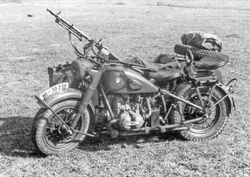The Kraftrad BMW R75 was a motorcycle used by Germany during World War II. It was the most extensively used German motorcycle of that period.
Description[]
The R75 was powered by a 26 hp, 750 cc BMW OHV petrol engine,[1] which replaced the original preproduction side-valve engine, and could travel at speeds of up to 95 km/h.[2] The R75 could be crewed by a single driver, but certain armed variants may have required an additional gunner. Without any armaments and no need for any additional crew, two passengers could be carried, one in the sidecar and the other behind the driver. The R75 was fitted with the BMW 286/1 sidecar,[2] of which third sidecar wheel was also driven by an axle connecting to the rear wheel of the motorcycle. The R75 measured 2.4 meters long, and weighed 420 kilograms. It had four speed forward, one speed reverse gearbox with adjustable ratios for on-road and off-road travelling, making the R75 extremely manoeuvrable and capable of traversing most terrains. While most R75 models were unarmed, certain vehicles serving in reconnaissance or combat roles could be armed with a 7.92 mm MG 34 or MG 42 machine gun on the sidecar.
History[]

An armed R75.
The R75 was designed by BMW in 1938 in response to the Wehrmacht's request for a suitable motorcycle, meeting certain criteria. The R75 was accepted during military testing, and production began in 1941. The Zündapp company had also designed a motorcycle at the same time, the Zündapp KS750, which ultimately proved to be a superior design to the R75. In 1942, upon the urging of the military BMW and Zündapp agreed to use standard parts on both R75 and KS750 designs, resulting in around seventy percent of the parts used on the two motorcycle designs being the same. This soon led to the designing of a Zündapp-BMW hybrid, designated the BW 43. The two companies also agreed to cease the manufacture of the R75 and KS750 once units produced reached 20,200, and from then on produce only the Zündapp-BMW design. The goal of 20,200 R75 models was never reached, and therefor the R75 remained in production until 1944, when Allied bombing raids had damaged the Eiesenach factory beyond repair. Another ninety-eight models were produced for the Soviet Union as part of war reparations.[1]
References[]
- ↑ 1.0 1.1 Commando Picture Story 4761 - Battle-Carrier!
- ↑ 2.0 2.1 http://www.bmbikes.co.uk/specpages/R75_sidecar_unit.htm
